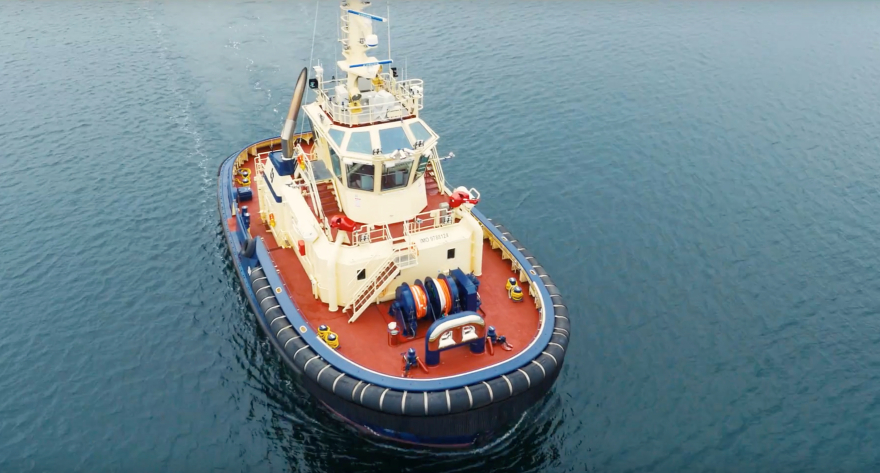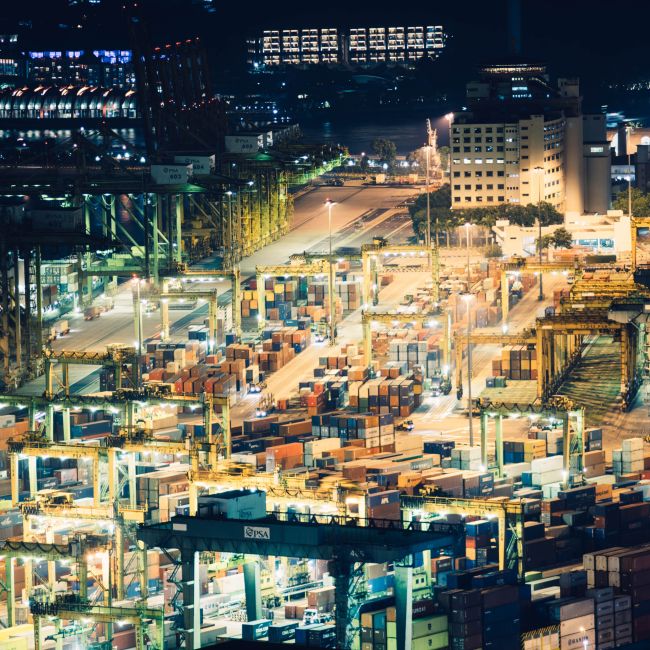From the handheld Black Hornets to the 40-meter wingspan of the Global Hawk and beyond, unmanned aircraft systems have already revolutionized warfare. At the same time, self-driving cars are bound to overhaul ground transportation. Look no further than Alphabet Inc.’s Waymo and the fresh, out-of-the-box robot taxi dream called Zoom.
With new developments in autonomous transportation happening at sea and on land, heavy industry is on the cusp of a revolution. Because the growing network of IoT systems integrating Big Data and Artificial Intelligence is changing not only the way we travel, but also the way we ship goods. Let’s look at two breakthrough IoT solutions for the freight and mining industries.
Svitzer Hermod – The World’s First Autonomous Ship
Over the past years, ship designers, operators and regulators have been designing a future where cargo vessels would sail the ocean with minimum or no crew. The industrial conglomerate Rolls Royce has even developed an innovative Ship Intelligence strategy for reshaping the marine business environment by harnessing the power of big data.
“Autonomous shipping is the future of the maritime industry. As disruptive as the smart phone, the smart ship will revolutionize the landscape of ship design and operations,” stated president of Rolls-Royce Marine Mikael Makinen.
In 2017, in collaboration with global towage operator Svitzer, Rolls Royce demoed the world’s first remote-controlled cargo ship that can be operated entirely without human crew. The 28m-long Svitzer Hermod, which was fully operated by its captain from a control room in Copenhagen harbor, stationed at the vessel’s remote base at Svitzer HQ, berthed alongside the quay, undocked, turned 360° and moved to the Svitzer HQ before docking again.
The Svitzer Hermod is equipped with a Rolls-Royce Dynamic Positioning System, which feeds the remote controlled system with real-time data. The vessel is also fitted with a wide range of IoT sensors which gather and combine different data inputs (including various types of radars, HD visual cameras, night-vision and life-based sensor systems, thermal imaging and LIDAR) to give the captain an enhanced understanding of the vessel and its whereabouts.

The Svitzer Hermod – Photo credits: Rolls Royce plc @Flickr
Recently, the company entered into partnership with Google to use the latter’s Cloud Machine Learning Engine to train its own AI-based object classification system so that it can detect and track surface objects that vessels can encounter at sea. And since the next step in the development of autonomous operations vessels will have to provide information and signals to other ships, the company is also looking at Google’s speech recognition system. This breakthrough will enable unmanned ships to automatically detect messages and send their own.
Autonomous ships like the Svitzer Hermod can monitor their own health, identify and communicate the surroundings as well as make decisions based on the data inputs generated by sensors that are vital to the development of autonomous operations. Since they no longer need to accommodate the crew, autonomous ships could also hold more cargo, reducing operational costs.
As the ship sensors and intelligent systems are already in testing with operators, Rolls Royce is planning to put an autonomous fleet into commission by 2020. In the long run, the company aims at building a robot boat control center operated by just 7 to 14 people, who would be able monitor and control an entire fleet of ship sailing around the world. Here’s the Star Trek inspired concept artwork presented in Amsterdam last year.
Over the last decade, Rolls Royce has been investing in the digital transformation of the marine industry, establishing an Intelligent Analytics Center in Norway and a Research & Development Centre for Autonomous Ships in Finland. So, we have plenty of reasons to expect even more innovative developments for the maritime transport in the near future.
Rio Tinto – Mine of the Future
In 2008, Australian mining giant Rio Tinto was kicking off its Mine of the Future program, introducing the first fully autonomous haul trucks.
“I smile when I hear the rush to develop autonomous vehicles by Uber, Google and pretty well every car company on planet Earth. Rio was the first mining company to introduce fully-autonomous haul trucks in 2008,” said Rio Tinto’s former CEO Sam Walsh at a conference earlier this year.
Rio Tinto’s autonomous trucks operate in huge, open-pit mines that are far away from the nearest place they can be serviced in case of breakdowns or malfunctioning. All the more reason for these trucks to be equipped with IoT sensors that enable preventive maintenance. Due to these sensors, the company is able to monitor the trucks’ condition and address issues before they affect operations. This complex IoT system reportedly saves the company $2 million per day every time a breakdown is avoided.
With 69 autonomous trucks in operation, Rio Tinto is now the largest owner and operator of autonomous haulage system trucks. But the company’s pursuit of innovation did not stop with the autonomous trucks. 10 years ago, the giant announced the AutoHaul Project – the autonomous train program designed for the transportation of iron ore to port facilities. Following a 3-year hiatus, triggered by the global financial crisis, the program was re-launched in 2011.
Rio’s self-driving trains, nicknamed AutoHauls, started running in autonomous mode in early 2017. At present, around 50% of pooled fleet rail kilometres are completed in autonomous mode (with drivers on board) and 90 % of pooled fleet production tonnes are AutoHaul-enhanced. In fact, the AutoHauls are proven to travel faster than human-operated trains. At this year’s Gartner Data & Analytics Summit in Sydney, Rio Tinto’s Growth & Innovation Executive Steve McIntosh said that “in recent trials the autonomous trains delivered the product to the port nearly 20% faster than a manned train.”
The “world’s largest and longest robots,” as McIntosh put it right before the approval of the AutoHaul by the Australian ruling safety board, are approximately 2.4 km long and feature 2 or 3 locomotives and 240 ore cars. The Artificial Intelligence system of these full-scale autonomous trains can actually decide on a better “driving strategy.” It’s because they have the capacity to understand data related to the topography, the carriage weight, the curvature of the railway and the corroboration of such data.
Tinto’s iron ore business includes 16 mines, 200 locomotives, over 1,700km of track, 3 ports, 3 power stations, and a water and sewer system across an area the size of New South Wales. Altogether, their operations generate 2.4 terabytes of data per minute from hundreds of pieces of mobile equipment and sensors that provide real-time data on location and condition monitoring of the equipment.
In order to handle such huge flows of data, the company built a state-of-the-art operations center that revolutionized the concept of mining. Located in Perth, this NASA control center lookalike makes it possible for the company’s mines, ports and rail systems to be operated from a single location. 16 individual mines are thus integrated into a unique mining processing and logistics system, which is controlled by operators 1,500km away from the physical sites.
The mining industry has a lot to gain from the connectivity provided by IoT systems. Rio Tinto’s control center relies on visualization and collaboration tools that provide real-time information across the demand chain, helping optimize mining, maintenance and logistics in a way that was never possible before.



The IoT Tipping Point: Everywhere | QUALITANCE
Posted at 16:41h, 25 July[…] traffic congestion, improved driver/passenger safety, increased mobility and emergency response. Interconnected devices also help shipping services track cargo and prevent theft and product damage; they optimize car park utilization, also known as smart […]